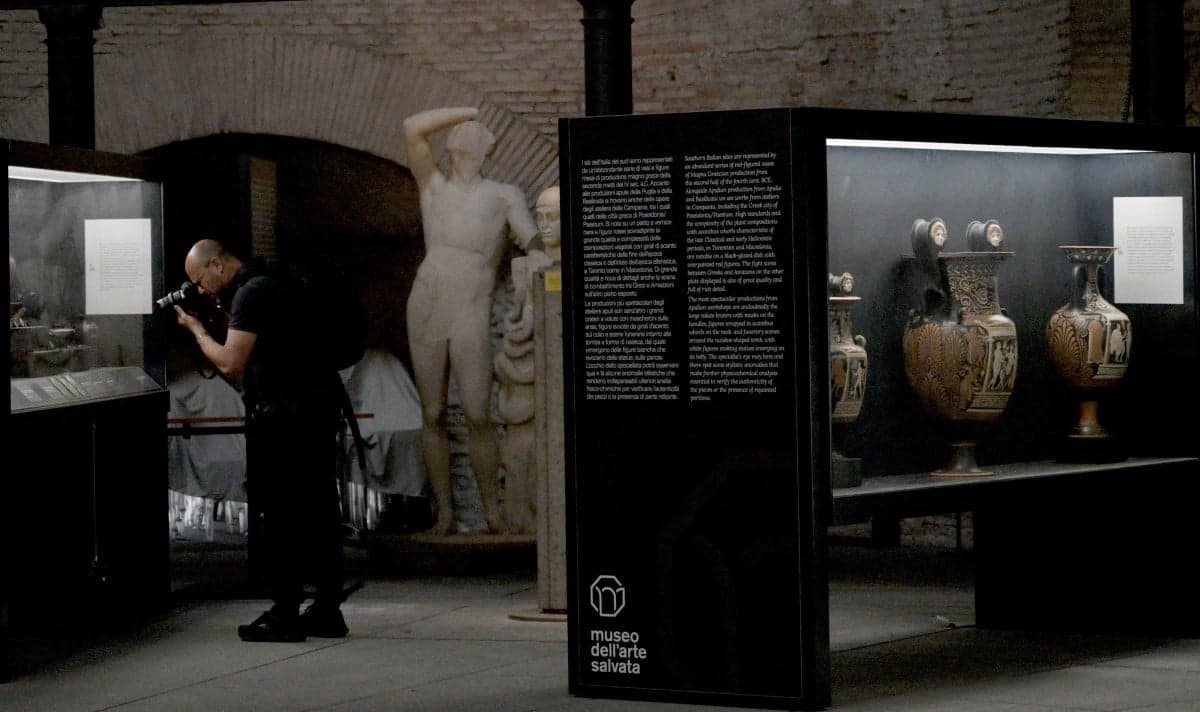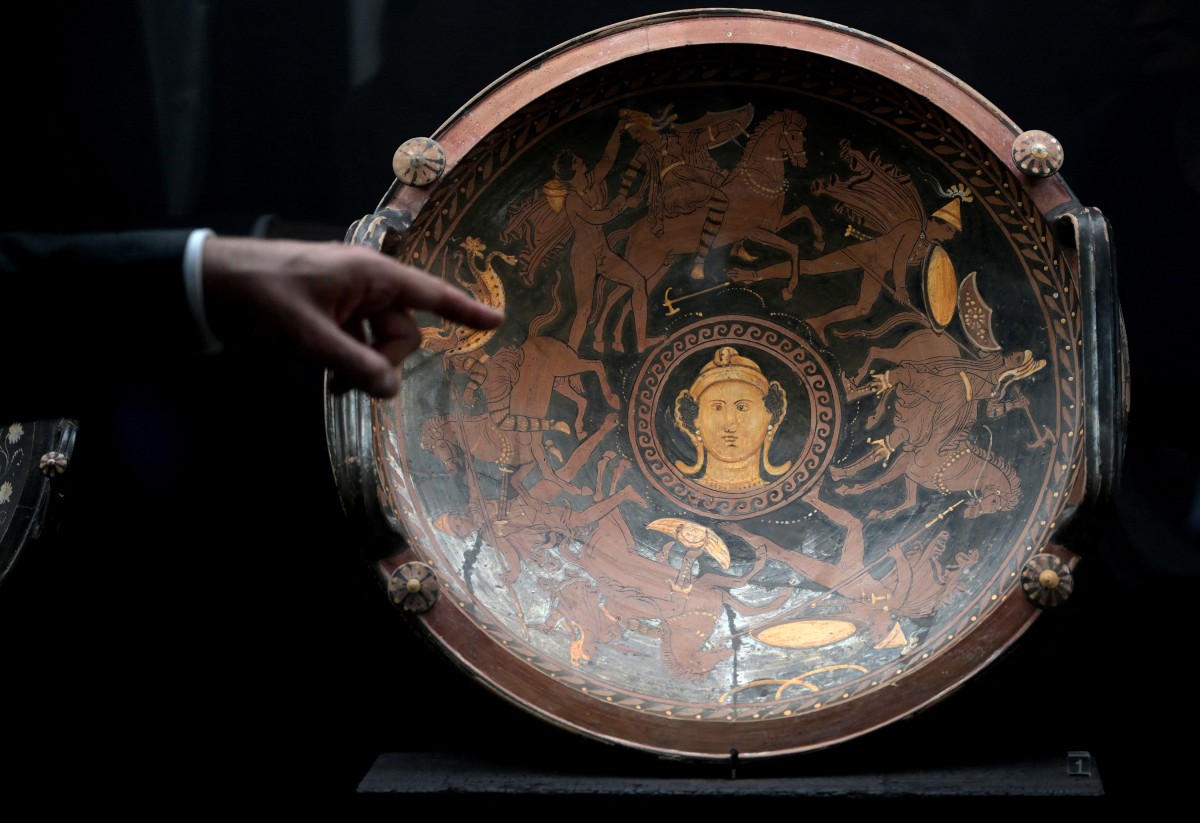Museum of Rescued Art showcases stolen relics returned to Italy

Antiquities recovered after being looted in Italy and sold on the global black market have found their sanctuary in the heart of Rome.
The 'Museum for Rescued Art' is housed in a spectacular hall within the majestic Diocletian Baths, ancient Rome's largest bath complex.
Currently holding dozens of amphorae, coins and busts, the museum stages rotating exhibits aimed not just at showcasing the art, but recounting how it was rescued.
Some of the antiquities were looted during illegal excavations of Etruscan necropolises north of Rome or from secret digs in the southern region of Puglia.
Many were smuggled out of Italy via a network of antique dealers and sold to foreign collectors.
Some of the objects highlighted were "resold or donated to major American museums" in the past, said museum director Stephane Verger, a French archaeologist.
Italy has waged legal and diplomatic battles lasting years as it seeks to recover its stolen artworks and plundered archaeological artefacts.
Two years ago it scored a major success.
The prestigious Getty Museum in Los Angeles agreed to return to Italy a group of three life-size terracotta statues known as "Orpheus and the Sirens" dating from the fourth century B.C., acknowledging they had been illegally excavated.

Director of the Museo Nazionale Romano Stephane Verger poses during a visit to The Museum for Rescued Art in Rome . Photo by Tiziana FABI / AFP.
They, too, made their way to the Museum for Rescued Art, part of a thematic exhibit on Italian terracotta.
"We don't want to be like those big museums and simply show beautiful works," Verger told AFP.
"It is an educational museum which shows all the dangers of international trafficking."
But the works do not stay here.
"After being exhibited for some time, they are repatriated to other Italian museums", Verger said -- precisely where they should have been all along had they not been smuggled out of the country.
Illegal excavations, such as when ancient burial sites are targeted by "tombaroli", or grave robbers, are damaging in two key ways.
Archaeologists are deprived of the looted objects themselves, but also key information on how, where and when they were found.
"Clandestine excavations have a very negative impact on our knowledge of ancient cultures," Verger said.
He added: "These days in archaeological work, context is about half the scientific value of the work."

Director of the Museo Nazionale Romano Stephane Verger points to exhibits during a visit to The Museum for Rescued Art in Rome. Photo by Tiziana FABI / AFP.
The museum, which opened two years ago, is temporarily closed due to construction works ahead of the 2025 Jubilee Year, in which millions of Catholic pilgrims are expected to visit Rome.
But when it re-opens, could it welcome "The Athlete of Fano", a splendid ancient Greek statue in bronze that has been at the Getty for nearly 50 years?
The European Court of Human Rights ruled earlier this month in favour of Italy's request to take back the statue, known in the United States as "Victorious Youth".
But Getty contests the decision and the case could be referred to the court's Grand Chamber for further examination.
Discovered 60 years ago by Italian fishermen off the Adriatic coast of Fano in central Italy, the statue is believed to have been immediately sold, changing hands several times before resurfacing on the art market in 1974.
The statue, which depicts a nude athlete with a wreath atop his head, was acquired from a German dealer by the J. Paul Getty Museum for nearly $4 million.
As to whether the athlete will make a stopover to Rome's museum, Verger said that "nothing is certain".
Comments
See Also
The 'Museum for Rescued Art' is housed in a spectacular hall within the majestic Diocletian Baths, ancient Rome's largest bath complex.
Currently holding dozens of amphorae, coins and busts, the museum stages rotating exhibits aimed not just at showcasing the art, but recounting how it was rescued.
Some of the antiquities were looted during illegal excavations of Etruscan necropolises north of Rome or from secret digs in the southern region of Puglia.
Many were smuggled out of Italy via a network of antique dealers and sold to foreign collectors.
Some of the objects highlighted were "resold or donated to major American museums" in the past, said museum director Stephane Verger, a French archaeologist.
Italy has waged legal and diplomatic battles lasting years as it seeks to recover its stolen artworks and plundered archaeological artefacts.
Two years ago it scored a major success.
The prestigious Getty Museum in Los Angeles agreed to return to Italy a group of three life-size terracotta statues known as "Orpheus and the Sirens" dating from the fourth century B.C., acknowledging they had been illegally excavated.

They, too, made their way to the Museum for Rescued Art, part of a thematic exhibit on Italian terracotta.
"We don't want to be like those big museums and simply show beautiful works," Verger told AFP.
"It is an educational museum which shows all the dangers of international trafficking."
But the works do not stay here.
"After being exhibited for some time, they are repatriated to other Italian museums", Verger said -- precisely where they should have been all along had they not been smuggled out of the country.
Illegal excavations, such as when ancient burial sites are targeted by "tombaroli", or grave robbers, are damaging in two key ways.
Archaeologists are deprived of the looted objects themselves, but also key information on how, where and when they were found.
"Clandestine excavations have a very negative impact on our knowledge of ancient cultures," Verger said.
He added: "These days in archaeological work, context is about half the scientific value of the work."

The museum, which opened two years ago, is temporarily closed due to construction works ahead of the 2025 Jubilee Year, in which millions of Catholic pilgrims are expected to visit Rome.
But when it re-opens, could it welcome "The Athlete of Fano", a splendid ancient Greek statue in bronze that has been at the Getty for nearly 50 years?
The European Court of Human Rights ruled earlier this month in favour of Italy's request to take back the statue, known in the United States as "Victorious Youth".
But Getty contests the decision and the case could be referred to the court's Grand Chamber for further examination.
Discovered 60 years ago by Italian fishermen off the Adriatic coast of Fano in central Italy, the statue is believed to have been immediately sold, changing hands several times before resurfacing on the art market in 1974.
The statue, which depicts a nude athlete with a wreath atop his head, was acquired from a German dealer by the J. Paul Getty Museum for nearly $4 million.
As to whether the athlete will make a stopover to Rome's museum, Verger said that "nothing is certain".
Join the conversation in our comments section below. Share your own views and experience and if you have a question or suggestion for our journalists then email us at [email protected].
Please keep comments civil, constructive and on topic – and make sure to read our terms of use before getting involved.
Please log in here to leave a comment.